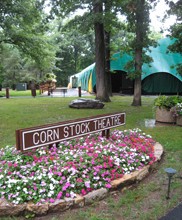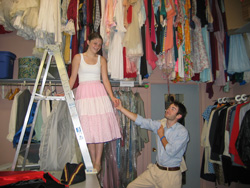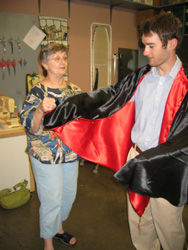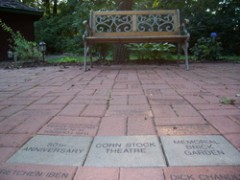Nestled in the lush foliage of upper Bradley Park, Corn Stock Theatre offers local thespians and theater patrons alike a creative outlet, a source of entertainment and a strong sense of community. Peoria’s only outdoor theater provides a tranquil viewing ambiance that makes it the “prettiest place to see theater in the area,” according to business manager Cindy Hoey. With a league of dedicated volunteers and a venue unlike any other, Corn Stock Theatre serves as a truly unique example of local, independent theater.
 The theater traces its roots back to a charter group of 70 members who banded together in 1954 to form Peoria’s first outdoor theater-in- the-round. On July 27th of that year, the novice troupe produced its first performance, Gigi, in Detweiller Park, holding another show later that summer in the same location. While these premier performances were quite successful, the theater troupe was in need of a permanent home.
The theater traces its roots back to a charter group of 70 members who banded together in 1954 to form Peoria’s first outdoor theater-in- the-round. On July 27th of that year, the novice troupe produced its first performance, Gigi, in Detweiller Park, holding another show later that summer in the same location. While these premier performances were quite successful, the theater troupe was in need of a permanent home.
Two years later, in a partnership with the Peoria Park District, Corn Stock Theatre planted its roots in upper Bradley Park. What began in 1956 as a large concrete-filled pit stage with railroad ties tiered for elevated seating has since evolved into an elegant and sophisticated outdoor theater. Unique to Corn Stock Theatre is its ability to transition between three-quarters round and full round. Both seating arrangements bring the stage right into the midst of the audience, so that each seat has a distinctive view of the performance. In 2003, the theater celebrated its 50th anniversary by welcoming the addition of a new, much-improved tent.
Aside from two paid employees, the theater is run entirely by a dedicated core of volunteers, which comprise a growing list of about 300. Approximately 100 volunteers contribute to each summer play season. Independent of any ownership, the theater is governed by a Board of Directors and attributes 95 percent of its income to ticket sales alone, making it almost entirely self-sustaining.
 Some might wonder how a volunteer-run organization manages to operate without chaos and discord. Corn Stock operates like a well-oiled machine, with a hierarchy of board members, committee members and workers at its helm. In charge of theater policy and budget is the twelve-member Board of Directors. Lining up plays, musicals and directors is the nine-member Play Selection Committee. Once the committee has chosen a director and decided on a production, the director puts together a cast and crew to see the show through.
Some might wonder how a volunteer-run organization manages to operate without chaos and discord. Corn Stock operates like a well-oiled machine, with a hierarchy of board members, committee members and workers at its helm. In charge of theater policy and budget is the twelve-member Board of Directors. Lining up plays, musicals and directors is the nine-member Play Selection Committee. Once the committee has chosen a director and decided on a production, the director puts together a cast and crew to see the show through.
Corn Stock Theatre hosts up to 12 productions in a year, with five plays in the summer, four to five in the winter and one or two children’s productions. As many as three shows may be in the works at once with the help of the secondary Corn Stock Lab Theatre. Although this facility isn’t as eye-catching as the main theater’s expansive blue-green tent, it allows the theater to continue operating during the winter months, when the tent is in storage.
The Lab Theatre also serves as a more experimental venue than the family-friendly tent. “It’s very cutting-edge,” said Hoey. “It takes more chances with productions.” The Lab Theatre features plays such as The Laramie Project, a non-traditional production which explores a community’s reaction to the historical murder of Matthew Shepard, and Urinetown the Musical, a satirical take on small-town politics.
In addition, the Lab Theatre is home to Corn Stock For Kids, a series of workshops and productions designed specifically for young aspiring thespians. Corn Stock For Kids offers a workshop in the summer and puts on one full-length production each winter.
With plays and musicals in constant production, the theater’s vast network of volunteers makes everything possible. From ushers and stagehands to set designers and directors, each position in the fully operational theater is filled by community volunteers. While everyone has a specific job description, the entire cast and crew pitches in on specific projects. At the end of each performance, the actors and crew—along with the actors and crew for the next production— all assist in disassembling the set and preparing the theater for the next show.
“It’s really amazing, all the time and energy people put into it,” said long-time costume designer Joanne Dowell. “You really give up your time for the community.”
It is this sense of community and tradition which is the essence of Corn Stock. While the theater openly recruits new helpers, some volunteers have been involved for decades, passing their dedication on to their spouses and children. Dowell and Hoey, the theater’s business manager, are two such examples.
Hoey has been a dedicated Corn Stock volunteer for over 30 years. She began with costumes in 1976, moved on to acting in 1979 and then to directing in 1981. In 2000, she was hired as one of the theater’s few full-time staff members. While she has enjoyed managing the theater, Hoey’s heart will always be set on directing. “I love the creative aspect of directing,” she said. “It’s very stressful at first, but once you’ve had experience, you become more relaxed.”
What attracts Hoey to theater is the unpredictability of live entertainment— no two shows are ever exactly the same. During one of her directing experiences, Hoey found herself dealing with a play that was too long and unfamiliar to her fellow volunteers. Over the Tavern was a hit in larger cities near Chicago, but largely unknown to central Illinois’ theater patrons.
“I knew the Corn Stock audience would really like it, but the show needed to flow to really work well,” she said. Hoey had to reformat the play’s long acts in addition to finding the perfect actor for the role of the play’s 10-year-old lead—a lead that would have to memorize over 50 percent of the play’s dialogue.
“Basically I was working with a show that people didn’t have a lot of confidence in,” she said. But the unexpected brought Hoey luck in first-time actor Trevor Miluer, who would go on to play the lead role flawlessly. “He turned out to be wonderful,” Hoey said of Trevor, who has continued to act in Corn Stock productions since his debut in Over the Tavern.
Obstacles like these can be challenging for novice directors, but Hoey emphasizes that it is important not to become discouraged. “You realize that some things you hadn’t planned on turn out to be better,” she said.
As the theater has allowed Hoey to explore her talents and interests over the years, it is a creative outlet for her family as well. Her husband, Gene Bourke, a long-time volunteer closely involved with seasonal set design, recently designed the set for this summer’s production of Incident at Vichy. Daughter Bridget Bourke also frequently lends a hand around the theater, helping out when her parents are involved.
Costumer Joanne Dowell has also found a niche at Corn Stock. Her costuming career began over 20 years ago when her daughter needed an outfit for a school theater production. She eventually began contributing her talents to Corn Stock shows. Through the community theater, Dowell found a comfortable place that would allow her to dabble year after year with a hobby that would blossom into a passion.
It was during her first few years at Corn Stock that Dowell met her mentor, Ginny Andrews. Andrews has been a costume volunteer since 1985, when she began volunteering on behalf of her son, an aspiring actor. Dowell and Andrews collaborated frequently on plays—Andrews as the head costume designer, and Dowell as a volunteer. Through Andrews’ support and encouragement, Dowell eventually took on the role of head costume designer. “She brought me along and encouraged me until I was brave enough to try it on my own,” Dowell said of her mentor. Since then, Dowell has taken on eight plays as head costumer and contributed to even more.
 This summer, Dowell dressed a small cast of eight for the July musical The Fantasticks. Among her subjects for this production were two young actors—Chris Adams-Wenger, a junior at Bradley University, and Andrea Williams, a junior at Richwoods High School. Chris and Andrea star as a young couple whose fathers coerce them to fall in love. Dowell’s playful interaction with her youthful leads set the tone for her open-minded mentality as a costume designer.
This summer, Dowell dressed a small cast of eight for the July musical The Fantasticks. Among her subjects for this production were two young actors—Chris Adams-Wenger, a junior at Bradley University, and Andrea Williams, a junior at Richwoods High School. Chris and Andrea star as a young couple whose fathers coerce them to fall in love. Dowell’s playful interaction with her youthful leads set the tone for her open-minded mentality as a costume designer.
For example, Dowell will always try to alter her cast’s costumes according to the weather. The play Incident at Vichy calls for most of the all-male cast to wear corduroy suits and long underwear. “It gets so hot under the tent…so we can ignore some of that,” she said. “I try to make my cast comfortable.” Her comfort adjustments include shortening sleeves, using lighter fabrics and avoiding long johns altogether.
It takes more than just sewing skills to run costume design. Patience, dedication and leadership are among some of the qualities that help Dowell complete play after play. “People have to be willing to delegate,” she said, when asked what it took to be a successful head costume designer. “Also, you have to be there throughout the entire performance, every night. If a seam rips or a zipper breaks… the actors like for you to be there.”
When she isn’t costuming, Dowell is still sewing; her other hobby is quilting. Through her quilting, Dowell finds a creative and artistic outlet, even putting on an art show with husband David, a ceramics professor at ICC. The show, titled “Hard and Soft,” featured Dowell’s quilts juxtaposed with her husband’s pottery. She also finds ways to incorporate quilting into her costume efforts. During one show, Seven Brides for Seven Brothers, she applied patchwork to seven wedding dresses for each of the female roles.
Like many loyal Corn Stock volunteers, Dowell has introduced her family to the theater over the years. Her husband occasionally joins her in painting sets, while her daughter, Ingrid, began acting in high school and continues today as a theater board member in charge of costume renewal and renovation. Ingrid even met her husband, Brian, through a production at Corn Stock. The two were married on 7/7/07, and Dowell couldn’t be more pleased. “Without Corn Stock, we wouldn’t be having our happy day coming up,” she said prior to the wedding.
The theater uses volunteers year-round in a wide variety of positions. “A common misconception is that we are closed to new members—this is not true!” said manager Cindy Hoey. “There are so many ways to get involved.” Directors, actors, crew members, designers and others are directly involved in play production. Ushers, box office workers and concessions workers all contribute their time during performances. Those interested in volunteering or other opportunities may contact the theater’s box office at 676-2196 or via email at [email protected]. For the theater’s play schedule, visit them on the web at www.cornstocktheatre.com. a&s


 Just as Corn Stock Theatre is an intimate and intricate arrangement of buildings and walkways, so is the dedicated group of volunteers that run it. To see just how many lives the theater has touched, visit the Commemorative Brick Garden located on the theater’s grounds. For the theater’s 50th anniversary in 2003, members and patrons were invited to engrave their favorite Corn Stock memory on a brick and have it joined permanently to the theater in the brick garden’s walkway. Similar to the theater’s namesake, its volunteers and the traditions they follow have deep roots firmly planted in the community.
Just as Corn Stock Theatre is an intimate and intricate arrangement of buildings and walkways, so is the dedicated group of volunteers that run it. To see just how many lives the theater has touched, visit the Commemorative Brick Garden located on the theater’s grounds. For the theater’s 50th anniversary in 2003, members and patrons were invited to engrave their favorite Corn Stock memory on a brick and have it joined permanently to the theater in the brick garden’s walkway. Similar to the theater’s namesake, its volunteers and the traditions they follow have deep roots firmly planted in the community.